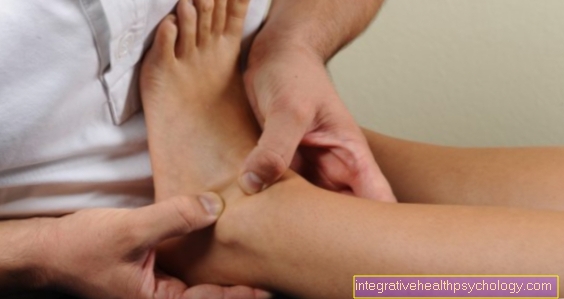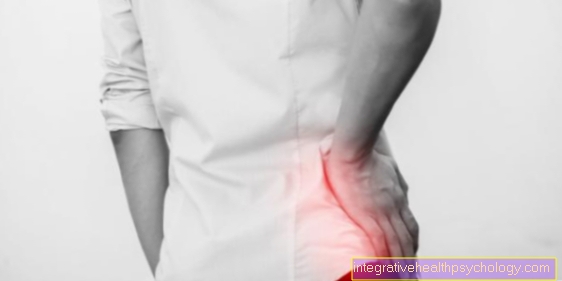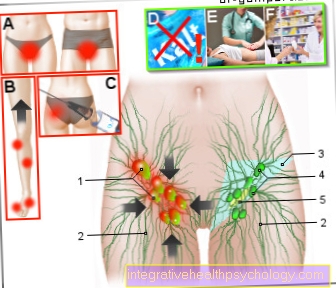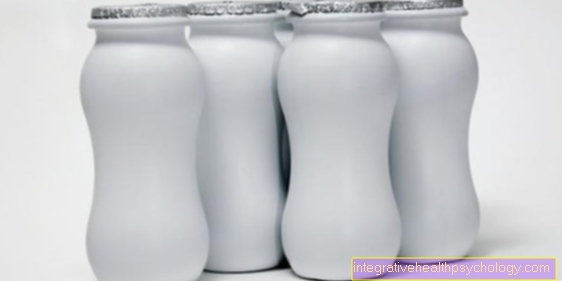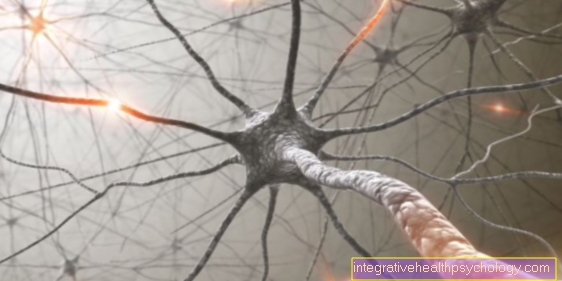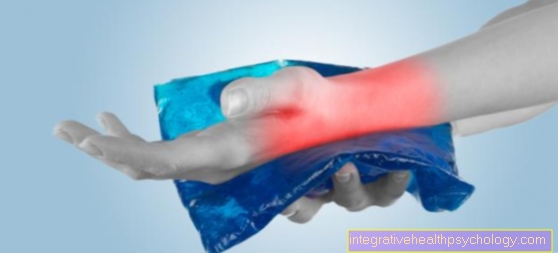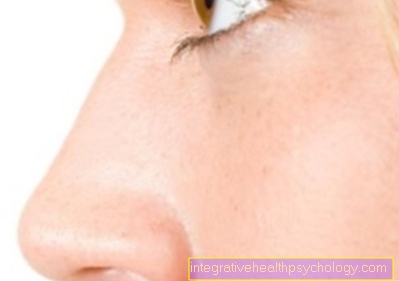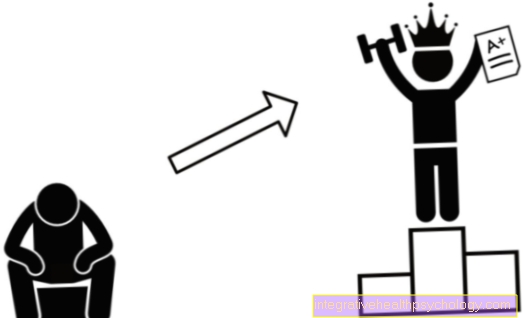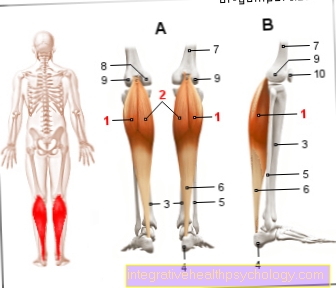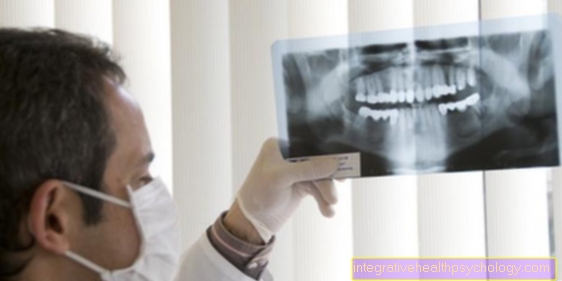Cause of cramps
introduction
A cramp is the contraction of the muscles, which is usually brief and differentiated from a muscle spasm or a contracture. The causes of cramps are diverse and are partly based on previous illnesses. There are also muscle cramps without any disease value.

Paraphysiological convulsions
Muscle spasms can be divided into three broad groups. On the one hand, there are paraphysiological cramps, which are among the most common cramps and the cause is a change in the electrolyte balance, for example due to heavy alcohol consumption, excessive sweating, physical activity or hyperventilation. Older people are also prone to paraphysiological muscle spasms, as muscles shorten with age and low fluid intake is an additional risk factor.
In addition, the electrolyte balance of a woman is changed during pregnancy and also during the menopause and is thus disturbed, so that paraphysiological muscle spasms can also occur here without any disease value. In these cases, the ratio of fluids to salts in the blood shifts due to decreased fluid intake or increased mineral loss.
Too little salt and minerals disrupts muscle arousal and premature muscle contraction.
Idiopathic convulsions
Another group of muscular cramps are idiopathic cramps. The exact cause for this is not yet known, but a genetic predisposition can be assumed.
Symptomatic cramps
The last group includes the symptomatic convulsions, which are caused by serious underlying diseases. These include diseases of the cardiovascular system, the brain and the nervous system, the hormonal balance, especially the thyroid gland, the muscles, circulatory disorders and orthopedic causes such as misalignments, mental disorders or the side effects of medication and poisoning.
Convulsions, colic, spasms
In addition to the three different groups of causes, cramps can also be divided according to their occurrence and type. For this purpose, the convulsions, colic and spasms are differentiated. Convulsions are often consecutive cerebral seizures that can be observed, for example, in epilepsy. Here not only individual muscle groups are affected, but muscle twitches all over the body.
In contrast, colic primarily affects the hollow organs of the gastrointestinal tract or the urinary system. This is where smooth muscle cramps occur. These are very painful and usually occur like attacks. These spasms can be caused by inflammation or stones that block a duct system such as the ureters.
Spasticity, on the other hand, is internal tension in the skeletal muscles that can be traced back to damage to the brain or spinal cord. However, spasms are also spoken of when there are cramps in the blood vessels or bronchi. They are then known as vasospasm or bronchospasm. For example, bronchospasm can occur as a result of bronchial asthma and cause shortness of breath.
Tonic cramps are long-lasting and very painful cramps that can be triggered, for example, by tetanus, also known as tetanus. In order to alleviate the symptoms, in addition to direct therapy of the cramps, it is important to recognize the correct cause and possibly an underlying disease and also to treat it.
The latest study results are debating whether the cause of the muscle spasms is primarily caused by a neuromuscular imbalance. Researchers and sports scientists assume that there is a disproportion between the so-called Golgi tendon organs and the muscle spindles, which leads to an increased muscle frequency and thus to muscle spasms. However, this hypothesis will be examined more closely in subsequent studies.
causes
Lack of water
Lack of water is a common cause of cramps. The reason for this is that a lack of water makes the blood thicker. Accordingly, nutrients, which are also important for the muscles, are transported more slowly and no longer adequately reach the tissue. This can be intensified by exercising. The body also loses water through sweating, which increases an existing lack of water.
This article might also interest you: Dehydration- How do you know if you're dehydrated?
Magnesium deficiency
Magnesium is an important mineral for the functioning of the muscles. It helps a muscle to relax again after contracting, i.e. contraction. Accordingly, a deficiency in magnesium leads to a disruption of muscle function. There is an involuntary contraction of the muscles, i.e. cramps. However, the thought that magnesium always helps against cramps should be considered with caution as there are often other causes of cramps as well. For example, a lack of water is more likely to cause cramps than a lack of magnesium.
Calcium deficiency
The mineral calcium is important to ensure the functionality of the muscles. Calcium is needed so that a muscle can contract, i.e. contract. Accordingly, a calcium deficiency leads to problems with muscle contraction. This can also cause cramps. However, calcium deficiency is more often associated with other symptoms such as increased fragility of the bones. Muscle cramps are not a typical symptom that suggests calcium deficiency.
With cortisone
Cortisone can also play a role in causing cramps. Normally, cortisone is produced in a similar form in the adrenal cortex and is involved, among other things, in regulating the electrolyte balance. Correspondingly, if the cortisone concentration is disturbed, some electrolytes, especially sodium and potassium, are disturbed.
These are essential for the proper functioning of the muscles. Correspondingly, cramps can occur in a disturbed cortisone household. In addition, long-term use of cortisone leads to insufficiency of the adrenal cortex, which can permanently disturb the cortisone balance in the body
Medication
There are numerous medications that can cause muscle spasms as a side effect. Among the most common are so-called diuretics, such as furosemide, which drain the body of kidney disease. As a result, the muscles in the body also lack the water and electrolytes that they need for their function. Muscle cramps can also be caused by so-called statins, e.g. Atorvastatin. These drugs are used to control excessive buildup of cholesterol in the blood. However, why they can also lead to cramps has not yet been sufficiently clarified.
diabetes
There are several types of diabetes that can lead to cramps. On the one hand, there is what is known as diabetes insipidus, in which an excessive amount of urine is produced and excreted due to a hormone disruption. This can lead to a lack of water in the muscles. The electrolytes are also out of balance in diabetes inspidus and can therefore influence the functionality of the muscles. On the other hand, diabetes mellitus, especially type 1, can lead to an increase in thirst and urination, which leads to the same consequences.
Kidney weakness
If kidney weakness is present, this can manifest itself as muscle spasms, among other symptoms. The reason for this is that when the kidneys are weak, there is a shift in the balance of electrolytes. These are essential for the muscles to function properly, as precise concentrations must be available so that the muscle can perform normal contraction (i.e., contracting) and relaxation. The water balance is also mixed up when the kidneys are weak. This causes the muscles to respond with cramps.
Hypothyroidism
Underactive thyroid, also known as hypothyroidism, affects muscles. The malfunction of the thyroid gland creates an imbalance in the hormones it produces. This weakens the transmission of signals from the nerves to the muscles. This is also known as reduced excitability. This makes the reflexes, such as the Achilles tendon reflex, slower.
However, muscle cramps are not a typical symptom of an underactive thyroid. They can more likely be the result of accompanying muscle weakness or pain from an underactive thyroid.
Find out more about the topic: Symptoms of an underactive thyroid
Parathyroid hypofunction
An underactive parathyroid gland, also known as hypoparathyroidism, typically leads to cramps. The reason for this is that the so-called parathyroid hormone, which is produced by the parathyroid gland, is responsible, among other things, for controlling the electrolytes in the body. Most importantly, the parathyroid hormone ensures that sufficient calcium is available in the body. If the parathyroid gland is underactive, less parathyroid hormone is produced accordingly. This also lowers the calcium level in the body and cramps in the muscles as they need the calcium for their function.
Read more on the topic: Parathyroid hypofunction
Addison's disease
Addison's disease is a disease of the adrenal cortex. As a result, it can no longer sufficiently produce the hormones aldosterone, cortisol and androgens. However, these are essential for many cycles in the body. This includes, for example, the control of the electrolytes. For example, aldosterone and cortisol ensure that there is enough sodium and not too much potassium in the body. This allows the muscles in the body to function well. A deficiency in these hormones leads to less sodium and too much potassium, which causes the muscles to cramp.
For more information, see: Symptoms of Addison's disease
Amytrophic lateral sclerosis
ALS, also known as amytrophic lateral sclerosis, is a complex disease of the nerves and muscles. This leads to a disruption of the transmission of information from the nerves to the muscles, which are normally responsible for the contraction, i.e. the contraction of the muscles. Accordingly, the muscles react with cramps. These occur mainly at night and are usually very painful for those affected. In the course of the disease, however, the cramps decrease and paralysis occurs.
Read more on the subject at: Amytrophic lateral sclerosis
Polyneuropathy
Polyneuropathy is a disease affecting several nerves in the body. This leads to various symptoms such as tingling, numbness, and cramps. The cramps mainly occur in the case of polyneuropathy caused by diabetes mellitus or long-term alcoholism. Both cramps and muscle weakness often occur here. The cramps are usually painful and are mainly on the lower legs and feet and only later affect the forearms and hands.
Read more on the topic: Symptoms of polyneuropathy
disc prolapse
A herniated disc affects the functioning of muscles. The area of the affected muscles depends on the height of the herniated disc. Depending on the severity and type of the herniated disc, the nerves that pull from the spinal cord into the muscles are irritated or pinched. In addition to pain, this can lead to numbness, cramps and paralysis. The cramps often occur in the calves.
Read more on the topic: disc prolapse
Cramps in the legs
Muscle contractions in the legs during exercise or at rest, for example during the night, which last a few minutes, are often painful and can be alleviated for many people by light stretching, massages or the intake of high-dose magnesium supplements.
Physical activity, a chronic underlying disease with neurological consequences such as diabetes mellitus, or a physiological cause such as the reduction in muscles in old age can be the cause of these special cramps. When there are cramps in the legs, the calf muscles are often affected.
Read more on the topic: Calf cramps
If the cramps in the legs occur several times a day, are very painful and cannot be combated, a doctor should be consulted to rule out an underlying illness. The doctor now has the opportunity to check the nervous system and muscle function using electromyography and electroneurography and also to check the function of some enzymes and hormones using a blood count. In addition, imaging tests such as ultrasound, CT and MRI can clarify the mechanical causes of the cramps.
Read more on the topic: Cramps in the legs
Cramps in hands and toes
It is not uncommon for the muscles of the arch of the foot or the toe muscles to cramp. This particularly affects people with a misaligned foot. Here, too, a frequent cause is a lack of magnesium, but too tight stockings, tight shoes or an unnatural posture due to excessive kinking can lead to an insufficient supply of blood. This creates a feeling of numbness or a tingling sensation, which can also develop into a cramp.
Cramps in the hands can be triggered by activities that are very stressful for the hands. These include, for example, work that involves a lot of writing or handicrafts. Performing unfamiliar work will strain muscles that are normally rarely used. Simple relaxation exercises and a few days' break from strenuous activity often help here so that the affected muscles can recover.
Read more on the subject at: Cramps in the hands and cramps in the toes
If the cramps occur more frequently with stress and cold and are accompanied by other symptoms such as paleness, cyanotic blue discoloration or redness and pain, Raynaud's syndrome must also be considered. This disease is one of the autoimmune diseases and triggers severe vasoconstriction or vascular spasms in the event of cold, stress or hormonal effects, which lead to insufficient supply of the fingers and toes. Raynaud's syndrome can also be triggered secondarily by vascular diseases such as ateriosclerosis, by trauma or by drugs such as cytostatics and poisons.
Depending on the cause, there is a different therapy. If it is low, preventive measures such as wearing gloves and socks are sufficient to prevent the fingers and toes, also known as acra, from getting cold. In severe forms of Raynaud's syndrome, alpha-receptor blockers, calcium antagonists or prostacyclin can be used to relieve symptoms and the occurrence of cramps. If this measure is not sufficient either, the ganglia of the sympathetic nervous system, which are responsible for the innervation of this area, can be surgically switched off. However, this is the last treatment option, as it has numerous side effects, such as excessive blood flow and impaired sweat secretion.
Cramps in the thighs
The thigh muscle cramp usually occurs suddenly and can be divided into two types according to the symptoms. Long-lasting cramps that usually last a few minutes and are very painful are called tonic cramps. The clonic cramps, on the other hand, are usually short-lived and can occur without pain.
The most common cause of this type of cramp is a lack of nutrients, which can be triggered, for example, by malnutrition, increased sweating or even severe diarrhea. A lack of magnesium in particular can very quickly lead to muscle cramps. A rapid change in temperature or from resting to high activity can overuse the muscle and cause cramping.
In addition to massages and nutrient supply in the form of magnesium supplements, targeted stretching exercises can provide acute relief from the symptoms, especially in the thigh cramp. In the case of a thigh cramp on the front that affects the quadriceps muscle, the lower leg should be bent and the foot should be brought to the buttocks.This stretch must be held for a few minutes if possible.
To stretch the back of the thigh and thus the sciocrural muscles, the leg should be stretched out. Bending the upper body towards the toes helps stretch the thigh. This position should also be held for a few minutes for acute relief. This can at least shorten the duration of the cramps.
However, if the cramps occur very frequently and cannot be controlled, a doctor should also be consulted in order to rule out a muscle disease. In general, it is important to find a balance between overloading the muscles and under-straining in order to prevent muscle cramps. Daily exercise and sport with warm-up training are useful for this. After exercise, the muscles should be stretched sufficiently and the body should be given a period of rest in order to regenerate and restore a balance in the electrolyte balance.
Read more on the topic: Cramp in the thigh







